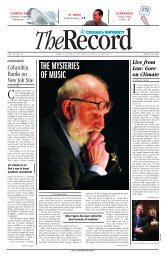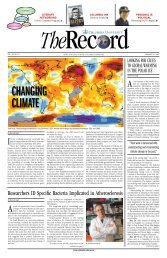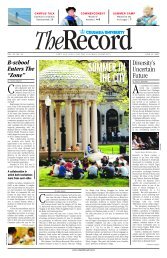September 06, 2007 - Columbia News - Columbia University
September 06, 2007 - Columbia News - Columbia University
September 06, 2007 - Columbia News - Columbia University
You also want an ePaper? Increase the reach of your titles
YUMPU automatically turns print PDFs into web optimized ePapers that Google loves.
6<br />
SEPTEMBER 6, <strong>2007</strong><br />
TheRecord<br />
RESEARCH NEWS<br />
Breaking <strong>News</strong> on Bones<br />
continued from page 1<br />
ation, according to the American Diabetes Association. Of the 14.6 million Americans<br />
who have been diagnosed with the disease, most have type 2 diabetes.<br />
Karsenty and his colleagues previously showed that leptin, a hormone<br />
released by fat cells, acts upon and ultimately controls bone mass. They reasoned<br />
that bones must in turn communicate with fat, so they searched bone-forming<br />
cells for molecules that could send signals back to fat cells.<br />
The researchers found that osteocalcin, a protein made only by bone-forming<br />
cells (osteoblasts), was not merely a structural protein, but rather a hormone<br />
with totally unanticipated and crucial functions. Osteocalcin directs the<br />
pancreas’s beta cells—which produce the body’s supply of insulin—to produce<br />
more insulin. At the same time, osteocalcin tells fat cells to release a hormone<br />
called adiponectin, which improves insulin sensitivity. Additionally, osteocalcin<br />
boosts production of insulin-producing beta cells, which is considered one of<br />
the best, but currently unattainable, strategies to treat diabetes.<br />
People with type 2 diabetes have been shown to have low osteocalcin levels,<br />
suggesting that altering the activity of this molecule could be an effective therapy.<br />
That conclusion is supported by the <strong>Columbia</strong> research showing that mice<br />
with high osteocalcin activity did not gain weight or become diabetic even when<br />
they ate a high-fat diet. Mice lacking the osteocalcin protein had type 2 diabetes,<br />
increased fat mass, a decrease in insulin and adiponectin expression and<br />
decreased beta-cell proliferation.<br />
This research was supported by the National Institutes of Health, the<br />
American Diabetes Association, the Japan Society for the Promotion of Science<br />
and the Pennsylvania Department of Health.<br />
The researchers are now examining the role of osteocalcin in the regulation<br />
of blood sugar in humans and are continuing investigations into the relationship<br />
between osteocalcin and the appearance of type 2 diabetes and obesity.<br />
-<br />
ROCK LYRICS SPEAK<br />
WORDS OF WISDOM<br />
By Diane Dobry<br />
F<br />
or decades, parents have worried that the<br />
lyrics to rock music could corrupt their children<br />
and poison their minds. But what of the<br />
intellectual and spiritual nuggets those lyrics<br />
may contain?<br />
In his new book, Rock ’n’ Roll Wisdom: What<br />
Psychologically Astute Lyrics Teach About Life and<br />
Love, Barry Farber, a professor of psychology and<br />
education at Teachers College, analyzes rock lyrics<br />
for their psychological truths.<br />
“The better lyricists within the rock tradition tell<br />
stories about life and use creative phrases and<br />
imagery to do so,” he says. “Like other artists,<br />
great songwriters offer the virtue of a more palatable<br />
way of learning than through the often-tedious<br />
pages of textbooks.”<br />
The book, which is published by Praeger<br />
Publishers, an imprint of Greenwood Publishing<br />
Group, is not typical of Farber’s oeuvre, which runs<br />
more to such articles titled “The Therapist as<br />
Attachment Figure” and “Clients’ Perceptions of the<br />
Process and Consequences of Self-Disclosure in<br />
Psychotherapy.” But given his research interests in<br />
psychotherapy and self-disclosure in patients,<br />
therapists and supervisors, it’s not too far a<br />
jump to the psychology of 50 Cent, Lil’ Kim and<br />
Snoop Doggy Dogg.<br />
“Rock lyrics, I believe, can be a lighthearted<br />
but engaging means to think about some profound<br />
issues of living,” Farber writes. “Specifically,<br />
I have looked for lyrics that illustrate in particularly<br />
insightful ways common human longings<br />
and concerns.”<br />
Farber groups rock lyrics into basic thematic categories,<br />
including love and friendship; pain; ways of<br />
coping, aging and growing; and the inevitable troika<br />
of sex, drugs and money.<br />
“‘Who am I?’ is one of the great questions of life,<br />
pondered by philosophers, artists, psychologists,<br />
and yes, songwriters,” Farber writes, noting that<br />
although the rocker Meat Loaf “made fun of such<br />
existential questions, he also noted implicitly that<br />
these are just the kind of things that many think<br />
about a good deal.”<br />
A chapter on death weaves together a discussion<br />
of Aerosmith, Jackson Browne, Simon and<br />
Garfunkel, John Prine, Billy Joel and Bonnie Raitt.<br />
Farber notes that in rock lyrics, “nostalgia seems to<br />
have two competing sides. One side pushes toward<br />
sweetening the past, the other clings to old regrets.”<br />
Farber also names the “50 Best Rock Lyrics” (in<br />
his opinion). They include selections from the<br />
Beatles, Bob Dylan, The Eagles, Joni Mitchell, Paul<br />
Simon and Billy Joel. The list is diplomatically presented<br />
in alphabetical order, beginning with the<br />
Beatles’ “And in the end the love you take is equal<br />
to the love you make” and ending with U2’s<br />
“We’re one, but we’re not the same/We get to<br />
carry each other.”<br />
Farber doesn’t dispute that the writings of great<br />
authors and psychologists go far deeper than rock<br />
lyrics. He admits, too, that many rock devotees don’t<br />
really listen to the lyrics. Still, he would like to see<br />
the “words” part of rock given more attention and<br />
serious consideration.<br />
LONGER PATERNITY LEAVE PUTS DADS IN THE LOOP<br />
By Record Staff<br />
M<br />
ost fathers take at least some leave from work to help care for their<br />
newborn children, and those who take longer leaves are more<br />
involved in their children’s care down the road, according to a study<br />
by two <strong>Columbia</strong> <strong>University</strong> social work professors.<br />
Providing some of the first evidence on paternity leave in the U.S., the study<br />
finds that an overwhelming majority of fathers take some leave after a birth. A substantial<br />
minority take a leave of two or more weeks, but those who do are more<br />
involved with child caretaking tasks when interviewed nine months later.<br />
Conducted by professors Lenna Nepomnyaschy and Jane Waldfogel at the<br />
School of Social Work, the report used data on more than 4,500 two-parent<br />
families from the “Early Childhood Longitudinal Study – Birth Cohort,” a<br />
new nationally representative study that is following a large sample of children<br />
born in 2001. The national study’s researchers interviewed mothers<br />
and fathers nine months after the birth, gathering detailed data about their<br />
involvement with the child and also asking whether they took any leave<br />
after the birth and, if so, how much.<br />
When asked whether fathers took any leave after the birth, the vast majority<br />
(89 percent) of families report that fathers take some time off work. “This is<br />
the first time we have had national data on fathers’ leave-taking, and this<br />
percentage is much higher than any of us would have expected,” said Waldfogel.<br />
However, the analysis also indicates that these leaves are quite short,<br />
with most fathers taking just one week or less and only a third of fathers<br />
taking two weeks or more.<br />
Fathers who are more highly educated and working in higher-prestige occupations<br />
are more likely to take leave and tend to take longer leaves than those<br />
who are less advantaged on those indicators. This result is consistent with prior<br />
evidence that higher-paying jobs are more likely to offer leave and to offer<br />
longer periods of leave.<br />
Fathers interviewed about their involvement with their children nine<br />
months after the birth shed new light on how leave-taking after the<br />
birth relates to subsequent involvement.<br />
“We wanted to know not just whether fathers are taking leave,<br />
but how that translates into later involvement with their children.<br />
Are fathers who take leave more involved with their children<br />
subsequently? Our analyses suggest the answer is clearly<br />
yes,” said Nepomnyaschy.<br />
“We find that fathers who take two or more weeks off work<br />
after the birth of their child are much more likely to participate<br />
in a range of child-care tasks when interviewed at nine months<br />
post birth than otherwise comparable fathers who did not take<br />
that much leave.”<br />
The child-care activities examined at nine months include<br />
diapering, feeding, dressing and bathing children.<br />
The full study, “Paternity Leave and Fathers’ Involvement with<br />
their Young Children: Evidence from the American ECLS-B,” will be<br />
published in the November issue of Community,Work & Family.






